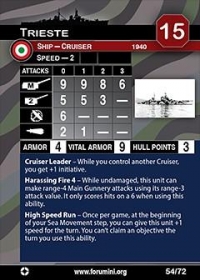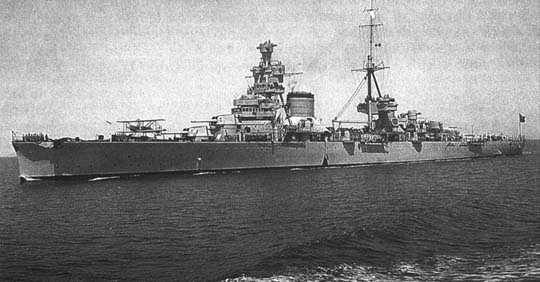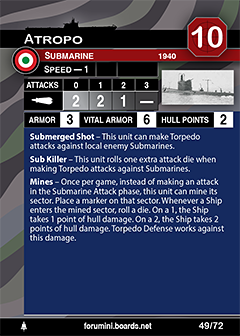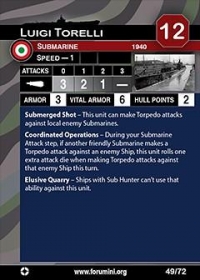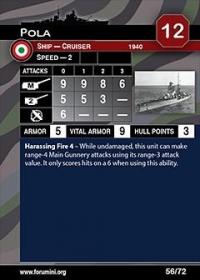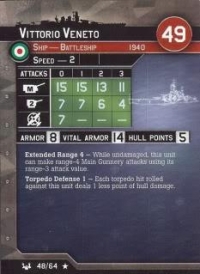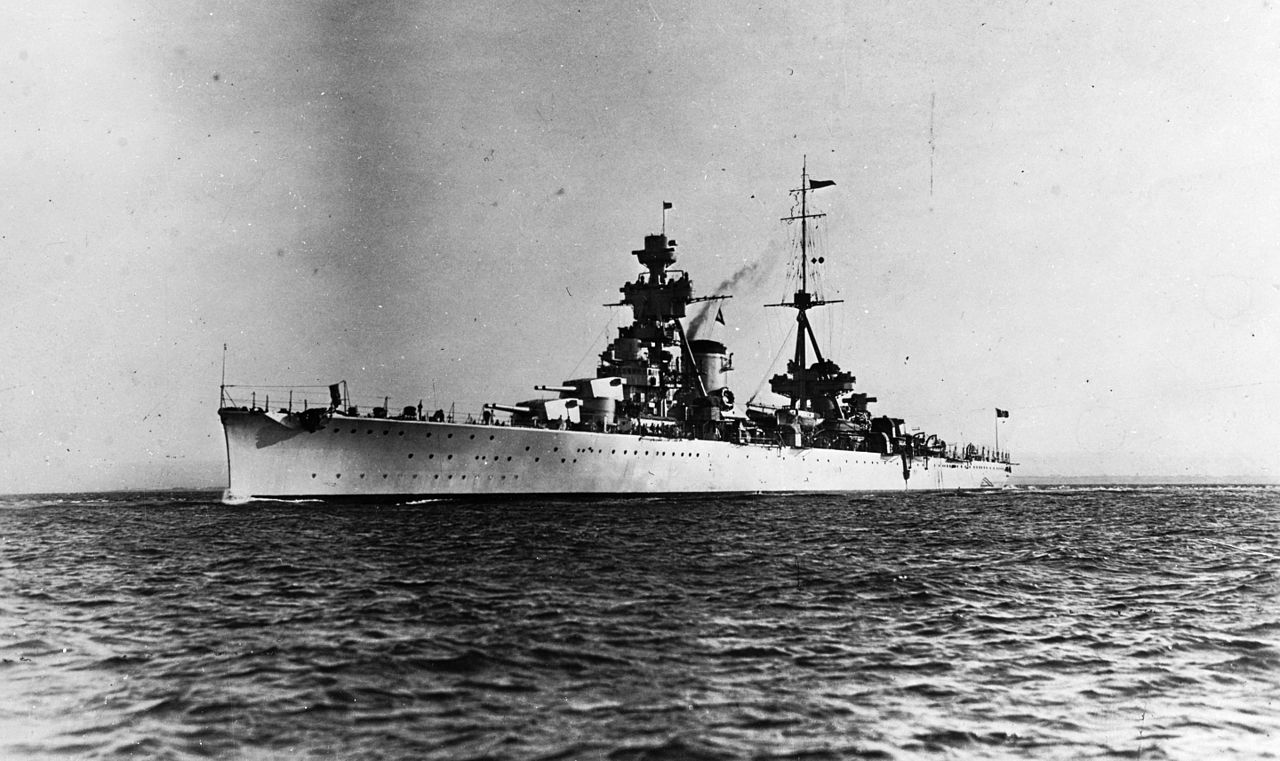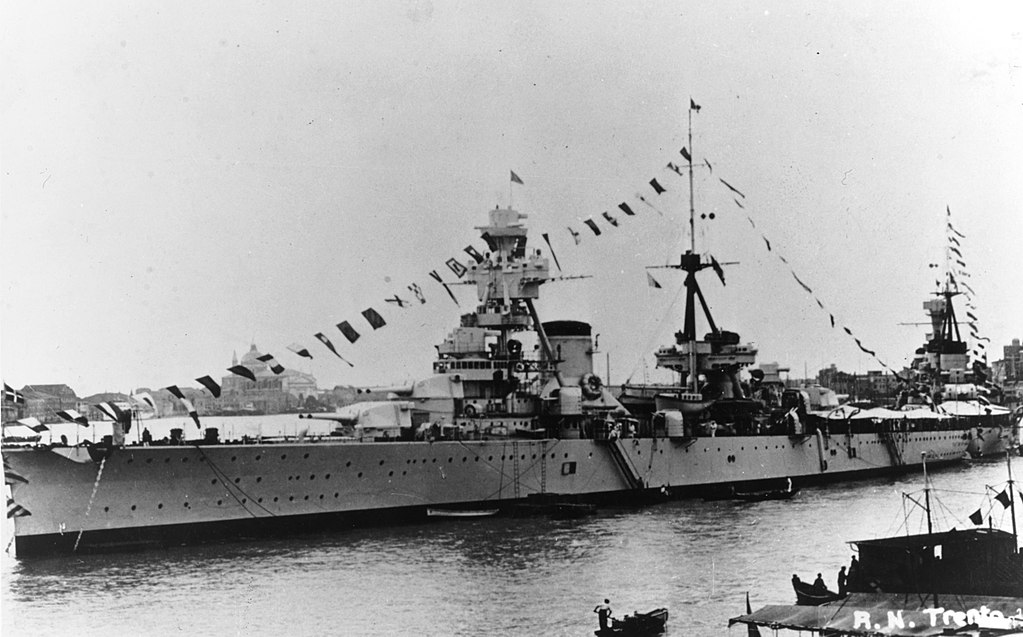Prototype: Trieste was the second of two Trento-class heavy cruisers built for the Italian Regia Marina (Royal Navy). The ship was laid down in June 1925, was launched in October 1926, and was commissioned in December 1928. Trieste was very lightly armored, with only a 70 mm (2.8 in) thick armored belt, though she possessed a high speed and heavy armament of eight 203 mm (8.0 in) guns. Though nominally built under the restrictions of the Washington Naval Treaty, the two cruisers significantly exceeded the displacement limits imposed by the treaty. The ship spent the 1930s conducting training cruises in the Mediterranean Sea, participating in naval reviews held for foreign dignitaries, and serving as the flagship of the Cruiser Division. She also helped transport Italian volunteer troops that had been sent to Spain to fight in the Spanish Civil War return to Italy in 1938.
The ship saw extensive action during World War II, including the battles of Cape Spartivento and Cape Matapan in November 1940 and March 1941, respectively. Trieste was also employed to escort convoys to supply Italian forces in North Africa; during one of these operations in November 1941, she was torpedoed by a British submarine. On 10 April 1943, while the ship was moored in La Maddalena, Sardinia, she was bombed and sunk by American heavy bombers. Her superstructure was cut away and she was refloated in 1950; the Spanish Navy purchased the hull in 1952, with plans to convert the vessel into a light aircraft carrier, though the plan came to nothing due to the growing costs of the project. She was ultimately broken up by 1959.
The ship saw extensive action during World War II, including the battles of Cape Spartivento and Cape Matapan in November 1940 and March 1941, respectively. Trieste was also employed to escort convoys to supply Italian forces in North Africa; during one of these operations in November 1941, she was torpedoed by a British submarine. On 10 April 1943, while the ship was moored in La Maddalena, Sardinia, she was bombed and sunk by American heavy bombers. Her superstructure was cut away and she was refloated in 1950; the Spanish Navy purchased the hull in 1952, with plans to convert the vessel into a light aircraft carrier, though the plan came to nothing due to the growing costs of the project. She was ultimately broken up by 1959.
Class History: The Trento class was a group of two heavy cruisers built for the Italian Regia Marina (Royal Navy) in the late 1920s, the first such vessels built for the Italian fleet. The two ships in the class—Trento and Trieste, were named after the redeemed cities of Trento and Trieste taken from the Austro-Hungarian empire after the victory in World War I. The ships were very lightly armored, with only a 70 mm (2.8 in) thick armored belt, though they possessed a high speed and heavy armament of eight 203 mm (8.0 in) guns. Nominally built under the restrictions of the Washington Naval Treaty, the two cruisers nevertheless exceeded the displacement limits imposed by the treaty.
In the interwar period, the two cruisers served in the Cruiser Division, frequently alternating as the divisional flagship. Trento made two extensive trips abroad, the first was a tour of South American countries in mid to late-1929 and the second was a deployment to China to protect Italian nationals during the Chinese Civil War. In 1938, Trieste assisted in the repatriation of Italian volunteer soldiers who had fought in Spain during the Spanish Civil War. Both ships saw extensive action in World War II, including the battles of Calabria, Cape Spartivento, and Cape Matapan. Trieste was damaged by a British submarine in November 1941 and therefore missed the First and Second Battles of Sirte, where at the latter action Trento damaged a British destroyer.
Trento was torpedoed and sunk by a British torpedo bomber and a submarine in June 1942 with heavy loss of life. In April 1943, Trieste was also sunk in port at La Maddalena during an attack by United States heavy bombers. Salvage operations began in 1950, and after it was determined that the ship's engines had been preserved by leaked fuel oil, the hull was sold to the Spanish Navy, which planned to convert the vessel into a light aircraft carrier. The plan was eventually cancelled in 1956 due to rising costs of the project, and Trieste was broken up for scrap in 1959
In the interwar period, the two cruisers served in the Cruiser Division, frequently alternating as the divisional flagship. Trento made two extensive trips abroad, the first was a tour of South American countries in mid to late-1929 and the second was a deployment to China to protect Italian nationals during the Chinese Civil War. In 1938, Trieste assisted in the repatriation of Italian volunteer soldiers who had fought in Spain during the Spanish Civil War. Both ships saw extensive action in World War II, including the battles of Calabria, Cape Spartivento, and Cape Matapan. Trieste was damaged by a British submarine in November 1941 and therefore missed the First and Second Battles of Sirte, where at the latter action Trento damaged a British destroyer.
Trento was torpedoed and sunk by a British torpedo bomber and a submarine in June 1942 with heavy loss of life. In April 1943, Trieste was also sunk in port at La Maddalena during an attack by United States heavy bombers. Salvage operations began in 1950, and after it was determined that the ship's engines had been preserved by leaked fuel oil, the hull was sold to the Spanish Navy, which planned to convert the vessel into a light aircraft carrier. The plan was eventually cancelled in 1956 due to rising costs of the project, and Trieste was broken up for scrap in 1959
Country: Italy, a European country with a long Mediterranean coastline, has left a powerful mark on Western culture and cuisine. Its capital, Rome, is home to the Vatican as well as landmark art and ancient ruins. Other major cities include Florence, with Renaissance masterpieces such as Michelangelo’s "David" and Brunelleschi's Duomo; Venice, the city of canals; and Milan, Italy’s fashion capital.


